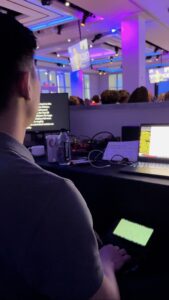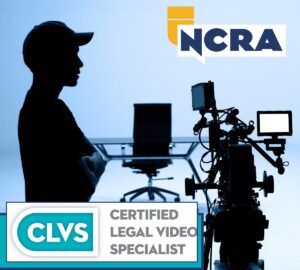If preparation is key to building great realtime, how does a captioner provide great captions without much information?
By Megan Rogers
Prepping for a captioning job – whether CART or broadcast – come down primarily to content, which further comes down to proper nouns and general background knowledge. Mark Smith, RPR, a broadcast captioner from Baton Rouge, La., points out: “We as captioners are creating that transcript on the fly to the best of our ability, and I think the only way to ensure we can do that is to thoroughly prep for each individual job.” He continues: “If crucial information in the form of names was paraphrased or omitted, it isn’t necessarily going to show up in the accuracy percentage; it’s simply going to be lost on the viewer. So I think captioners basically have to police themselves in this regard, since for a live event, there is no ultimate, verbatim transcript floating around out there and no real way to quantify the presence or absence of content without such a transcript.”
Fortunately, there are a variety of ways to gather the necessary content prior to a captioning job. “The type of prep I do depends on the type of job. For instance, if it is a business meeting/teleconference, the prep is mainly from the consumer and consists of names of participants, who is leading the meeting, and perhaps a list of words that will be used. It is also important to have the title of the meeting. If the job is a class, I will look at the syllabus, go online, and see if there are any class notes. (That is assuming I have the privilege of going onto their online class Blackboard type system.) If it is a conference, I will go and get the program online, get the abstract for my particular sessions, get the bios of speakers, look all over the website for sponsor names, Board members’ names, keynote speakers’ names, etc. If I am captioning an entertainer, I will Google them and watch video clips in order to get a sense of their show and their cadence,” says Patricia Graves, RDR, CRR, CCP, a CART captioner from Monument, Colo.
For jobs like talk shows or sports broadcasts, after gathering proper nouns, the best method of prepping involves doing some background research. “A celebrity is usually on a talk show to promote their latest movie or some other endeavor. Be sure to also research the celebrity’s past movies/TV shows, spouse(s), children, or any other current events surrounding that celebrity,” says Darlene Parker, RPR, a broadcast captioner from Reston, Va. “With professional and college sporting events, captioners are usually on their own. Once the captioner has the names of the teams, s/he can find the rosters online. As with celebrities, it’s important to be up on the latest news surrounding the players and teams. Is the team headed to the playoffs? Is there a controversy surrounding the team or a particular player?”
“Visit relevant websites and use search engines. If an initial search doesn’t turn up anything, keep trying with other search terms,” recommends Smith. “Something like a sports roster tends to be readily available and usually in one place, but information for a local newscast can be a tougher job, since names are spread across many different stories on the website.”
However, Parker points out that captioners have a legal right to get content ahead of time from the content providers. “Local news stations have an Electronic News Production system, which contains the rundown and most scripts of the upcoming newscast. Although some stations are reluctant to grant the captioner access, it is important to make a case to the station that the captioner can only provide the best captions possible if he or she is allowed access to the rundown and scripts. Be sure to explain that providing access is the only way the captioner can program his or her dictionary in order to be sure all proper nouns or unusual terminology is spelled correctly. It’s also important to emphasize that access should be ‘read only.’ We don’t want to accidentally change or delete a script. This will hopefully ease any anxiety that they station may have,” Parker adds. “If stations or content providers are still reluctant to provide prep, you can gently draw their attention the FCC order of March 2015 stating that prep should be provided when possible.”
Once all the proper nouns and background information is gathered, both Smith and Graves recommend having the necessary notes at hand. “It may be useful to have a physical printout of the names in case there isn’t enough space on the computer screen, particularly if there are many different names involved in the job,” says Smith.
“I print the materials in a font that is easy to see when I am writing,” says Graves. “I go through the printed materials and the online materials and I like to make lists of words and names based on the printed materials or online materials. I like to alphabetize those lists and I put my steno next to the names and can quickly refer to that on the fly. I also write the steno on my printed materials for quick reference. When writing, I have all these papers within eyes’ or hands’ reach!”
Even with all this content prepping, be prepared to make any necessary adjustments during the job itself. “I have also had the experience of entering an unusual or foreign name into my dictionary only to have it come up in the show and realize it was being pronounced very differently than I had entered it according to my steno theory. Since it may be difficult to determine how these names are pronounced beforehand, fingerspelling may be a useful alternative in these cases, instead of hoping to remember on the fly the exact steno you used to enter it,” says Smith.
Of course, the next step of prepping is making sure the content will get to the viewer. The other piece to prepping for a captioning job is making sure the hardware and software are ready to go. “For each and every show, it’s very important to test the connection between the writer and CAT software and also between the CAT software and caption delivery program, if applicable, to ensure captions are flowing. Also, make sure all of the dictionary prep work you do counts by enabling whatever dictionaries are applicable to the show. The last thing that needs to happen is forgetting to enable the dictionary you just spent significant amounts of effort creating,” says Smith.
Parker also points out that it’s important to perform regular dictionary maintenance. “Clean out old briefs. Do not get burned by using the same brief form for two different people – and forget which one is in your top dictionary, which is the one that will translate,” she says.
“Of course, the biggest and most important factor is the decision to do the prep in the first place,” says Smith. Graves confirms this: “Prepping also takes away a degree of anxiety.” After all, the point of prepping – gathering proper nouns, being familiar with background knowledge, and testing the technology – is ensuring that the captioner is able to perform as a top-notch professional.
Megan Rogers is NCRA’s Communications Assurance Specialist. She can be reached at mrogers@ncra.org.







